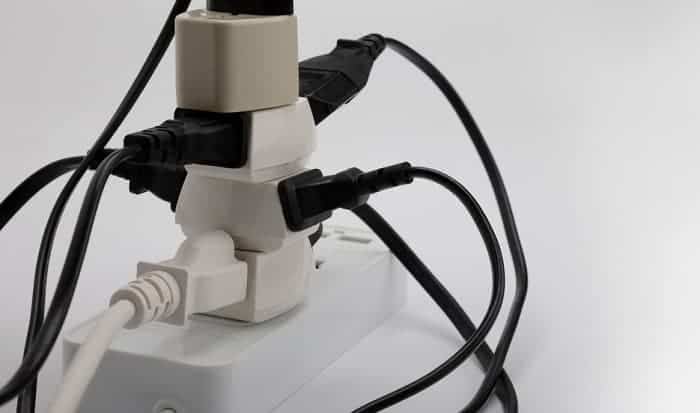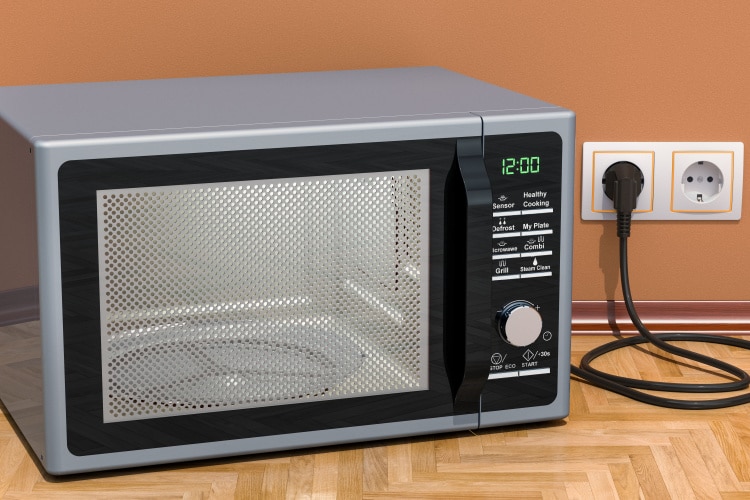One common question regarding circuits and outlets is how many outlets you can safely wire to a 20 Amp circuit. So, what’s the answer?
Technically speaking, you are free to add as many outlets as you like per circuit. There aren’t clear restrictions by the National Electrical Code (NEC) on how many outlets should be installed on a 20 Amp circuit.

There is, however, a regulation restricting the number of outlets you can simultaneously use per circuit. The limit is based on the total Amp draw, also known as the 80% NEC Rule.
Let’s learn more about this rule and how it impacts 20 Amp circuits.
How Many Outlets Can a Single 20 Amp Circuit Handle?
According to the NEC, a circuit cannot deliver more than 80% of its power capacity to its outlets. This restriction prevents the circuit breaker from “tripping” as a result of overloads. If we multiply 20 Amps by 0.8 (80%), we’ll find that a 20 Amp circuit can only supply outlets with 16 Amps, or 1,920 Watts, of electricity.
The National Electric Code also advises using up to 1.5 Amps per outlet. This way, you would evenly distribute the electric load throughout them.
Considering the 80% NEC rule and the recommendation of 1.5 Amps per outlet, you should wire no more than 10 outlets per 20 Amp circuit (20 Amps x 0.8 = 16 Amps; 16 Amps / 1.5 = 10.6).
What Would Happen if You Wire More Than 10 Outlets on a 20 Amp Circuit?
Nothing bad will happen if you wire more than 10 outlets on a 20 Amp circuit, as long as you’re careful not to exceed the 1,920 watts of electricity per 20 Amp circuit. However, tracking how much wattage plugged-in appliances consume at each moment is tricky, so going over the 10 outlet recommendations is discouraged.
If you must install more than ten outlets in an area, splitting them into two 20 Amp circuits would be optimal.
For instance, if you need 14 outlets, the ideal solution would be installing two 20 Amp circuits with 7 outlets on each. Should you ever need more outlets, you’ll have enough room on both circuits to add more outlet space.
Additionally, the majority of people purchase power strips and surge protectors. They’re extension cords with multiple slots, enabling you to plug various devices into the same outlet.
Using these devices to fill an area lacking in outlets is a great idea, with surge protectors being the better choice out of the two. In addition to multiple outlet spaces, surge protectors shield devices from dangerous power surges.
However, since they’re plugged into one outlet, they have limitations on how much power they can safely use without overloading the outlet and tripping the circuit. In the case of 20 Amp circuits, the rule is 1,920 watts of electricity.
Surge protectors could temporarily solve the problem of lack of outlet space. However, as we already said, you must never surpass 1,920 watts of electricity from a single circuit, meaning you can’t stack them up with devices that may potentially exceed that limit. So always keep the number of powered receptacles to a minimum, and power low-wattage devices like a PC, TV, lamp, modem, gaming console, router, etc.
Can Circuits & Lights Be Wired on The Same 20 Amp Circuit?
The NEC permits the connection of lights and outlets to a 20 Amp circuit, but it’s best to place the former on a separate circuit.
Sockets should be wired on 15 Amp circuits, whereas receptacles on 20 Amp circuits. The norm is made strictly for improving functionality, so it isn’t a necessity.
Here’s how to wire a lamp into a 20 Amp circuit while remaining within regulation.
If you raise the number of lamps on a circuit, you must decrease the number of outlets. For instance, if you connect two light fixtures to a 20 Amp circuit, you can’t use more than eight outlets on it.
So why is this practice discouraged? Merging lights and outlets become dangerous if you are uncertain which outlets and lamps go on which circuits. Also, plugging more high-consumption devices into a circuit that also powers lights could lead to an electrical overload. Electricians generally recommend keeping lights and outlets on separate circuits to avoid confusion and prevent overloading.
What to Plug on a 20 Amp Circuit?
The kitchen is one area where the National Electric Code requires 20 Amp outlets. This requirement is implemented because kitchen appliances are constructed with motors and heaters inside, almost always consuming more energy than other devices within your home.
More specifically, the NEC mandates installing at least two 20 Amp outlets in the kitchen. Thanks to this, you’ll have higher amperage available to run your electronics without overloading the circuit.
You may plug the following devices into a 20 Amp circuit:
- Blender
- Toaster
- Mixer
- TV
- Space heater
- Vacuum cleaner

Heavy-duty appliances fall into a separate category group because of their high wattage requirements. These devices require their own designated circuit to operate.
A dedicated circuit has a separate circuit breaker and serves only one outlet. That means only one electrical device is inserted into that outlet and gets power from that dedicated circuit.
Appliances in need of a 20 Amp dedicated circuit are some of the following:
Conclusion
When adding outlets, you may wonder how many of them you’re able to safely plug into a 20 Amp circuit. Since you’ve made it this far, you now know the answer is not so straightforward. So, let’s summarize!
A 20 Amp circuit can securely power up to 10 outlets without operating at over 80% of its peak capacity. For these circuits, that equates to 16 Amps, so one outlet for every 1.5 Amps of the 80% limit is a good rule of thumb.
If you need more outlets, the easiest solution is to create an extra 20 Amp circuit and evenly split the number of outlets between the two circuits. Power strips and surge protectors are also a great but temporary solution.
Pushing a circuit’s or a circuit breaker’s limits could have disastrous results that may end in a fire. So, always consult with an expert electrician for whatever plan you intend to realize electricity-wise.